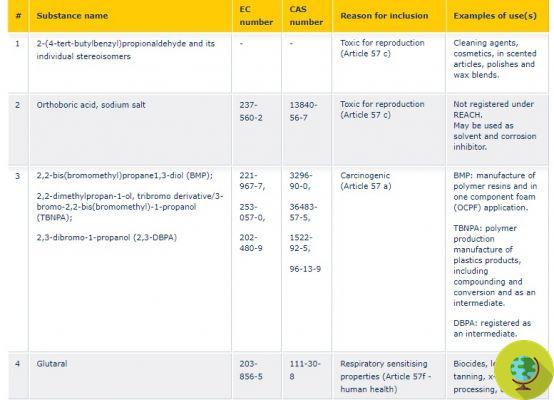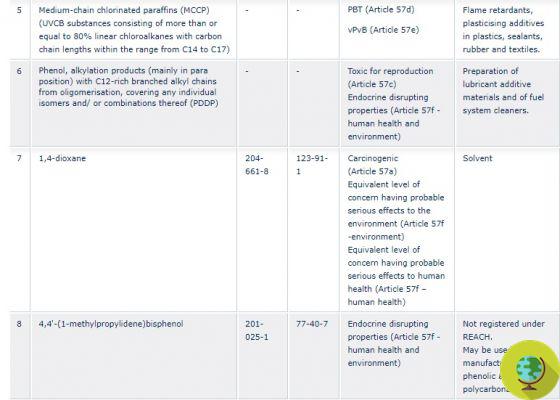ECHA updated the List of Substances of Very High Concern by adding 8 including bisphenol B and paraffins
Don't store avocado like this: it's dangerousECHA has updated the list of potentially dangerous chemicals, defined as "extremely worrying", adding 8. This extends the list which now includes 219 substances that can harm people or the environment and which, therefore, are strictly regulated.
The European Chemicals Agency (ECHA) has added new substances, used in consumer products such as cosmetics, fragrance articles, rubber and textiles, to the already long list of potentially dangerous chemicals that can have serious effects on our health or on our environment. Some are used as solvents, flame retardants or to make plastic products.
With this update (ECHA reviews the list twice a year), 219 substances are included in the REACH candidate list (European Union regulation concerning the registration, evaluation, authorization and restriction of chemicals), but in reality as some of these cover groups of chemicals, the overall number may be higher.
The 8 added substances are the following:
- 2- (4-tert-butylbenzyl) propionaldehyde and its single stereoisomers: substances that are toxic for reproduction that are used in detergents, cosmetics, perfumed articles, polishes and mixtures of waxes.
- orthoboric acid, sodium salt: toxic for reproduction, even if not registered in REACH it can be used as a solvent and corrosion inhibitor;
- 2,2-bis(bromomethyl)propane1,3-diolo (BMP); 2,2-dimethylpropan-1-ol, tribromine derivative / 3-bromo-2,2-bis (bromomethyl) -1-propanol (TBNPA); 2,3-dibromo-1-propanol (2,3-DBPA): carcinogenic substances. Depending on the type, they are used in the production of polymer resins, polymers, in one-component foam applications (OCPF) and in the manufacture of plastic products.
- Glutaraldehyde: has a sensitizing effect on the respiratory tract. Substance used in biocides, leather tanning, X-ray film processing and cosmetics;
- MCCP – Medium chain chlorinated paraffins: persistent bioaccumulating and toxic (PBT) substances, used as flame retardants, plasticising additives in plastics, sealants, rubber and fabrics;
- phenol, alkylation products (mainly in the para position) with branched or linear alkyl chains rich in C12 from oligomerization, which cover any single isomers and / or their combinations (PDDP): toxic for reproduction and endocrine disruptors. They are used in the preparation of additive materials for lubricants and detergents for fuel systems;
- 1,4-dioxane: carcinogenic substance and likely to have serious effects on human health and the environment. It is used as a solvent;
- 4,4 ′ - (1-methylpropylidene) bisphenol (bisphenol B): endocrine disruptor, not registered in REACH, it can be used in the production of phenolic resins and polycarbonate.

@ECHA

@ECHA
We have already talked about Bisphenol B as it has long been suspected that this substance acts like Bisphenol A. (Read also: Not only Bisphenol A: "Bisphenol B is also an endocrine disruptor", France asks for new rules) .
Most of the substances, as stated on the ECHA website, have been added to the list as toxic for reproduction, carcinogenic, respiratory sensitizers or endocrine disruptors. So the concerns are about human health.
Because of this:
Companies must comply with their legal obligations and ensure the safe use of these chemicals. They must also notify ECHA, under the Waste Framework Directive, if their products contain substances of very high concern. This notification is sent to ECHA's SCIP database and the information will subsequently be published on the Agency's website.
Importers and producers of articles using one or more of these substances have six months from the date of its inclusion in the list (8 July 2021) to inform ECHA. Suppliers of substances on the Candidate List (supplied alone or in mixtures) must provide their customers with a safety data sheet.
As ECHA writes:
Under REACH, companies may have legal obligations when their substance is included - on its own, in mixtures or in articles - in the Candidate List. Any supplier of articles containing a Candidate List substance above a concentration of 0,1% weight by weight must provide sufficient information to their customers and consumers to enable safe use.
In the future, these same substances could be included in the authorization list, which means that companies would have to apply for a specific authorization in order to continue using them.
- Follow your Telegram | Instagram | Facebook | TikTok | Youtube
Source: ECHA
Read also:
- Not just bisphenol and phthalates: plastic contains 140 harmful substances and is a threat to human health
- Bisphenol S: is the bisphenol A substitute equally harmful?
- “Girls develop breasts at age 8 due to the bisphenol in plastic”, say the experts
- BPA: We are probably exposed to Bisphenol A a lot more than we always thought


























